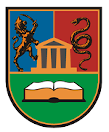Please use this identifier to cite or link to this item:
https://scidar.kg.ac.rs/handle/123456789/19157Full metadata record
| DC Field | Value | Language |
|---|---|---|
| dc.rights.license | Attribution-ShareAlike 3.0 United States | * |
| dc.contributor.author | Katanić Stanković, Jelena S. | - |
| dc.contributor.author | Matić, Sanja | - |
| dc.contributor.author | Jurić, Tatjana | - |
| dc.contributor.author | Ramazan, Ceylan | - |
| dc.contributor.author | Mihailovic, Vladimir | - |
| dc.contributor.author | Stanić, Snežana | - |
| dc.contributor.author | Gökhan, Zengin | - |
| dc.date.accessioned | 2023-10-26T11:44:46Z | - |
| dc.date.available | 2023-10-26T11:44:46Z | - |
| dc.date.issued | 2018 | - |
| dc.identifier.isbn | 978-86-912591-4-3 | en_US |
| dc.identifier.uri | https://scidar.kg.ac.rs/handle/123456789/19157 | - |
| dc.description.abstract | The methanolic extracts of aerial parts of two species from the genus Onosma L. (Boraginaceae), Onosma sericea Willd and Onosma stenoloba Hausskn. ex Riedl from Turkey, were tested for their biological potential. Antimicrobial activity of Onosma extacts was assessed by microdilution method using selected bacterial and fungal strains. The comet assay was performed to evaluate the in vivo genotoxic and protective effect of Onosma extracts at different concentrations (20, 40 and 80 mg mL-1) against the ethyl methanesulphonate-induced DNA damage in Drosophila melanogaster. The in vitro ability of extracts to protect DNA against hydroxyl radical was estimated. The contents of total phenolics and flavonoids in the extracts were also determined by spectrophotometrical measurements. Antimicrobial activity of tested extracts was moderately pronounced, with the lowest minimal inhibitory concentration values (MIC) of 2.5 mg mL-1. Extracts at higher concentrations showed the absence of genotoxicity. The antigenotoxic effect was evident after treatment with both extracts with percentage reduction over 80%. In concentration range from 25 to 400 μg mL-1, the protective effects of the extracts against hydroxyl radical-induced DNA damage were dose-dependent, increasing with higher dosages. The results showed much higher content of total phenolics in O. sericea than in O. stenoloba extract (69.79 and 32.46 mg GAE g-1, respectively). Flavonoids were the dominant class of bioactive compounds in O. sericeum extract (52.62 mg RE g-1), while they were present in O. stenoloba extract in much lower quantity (8.36 mg RE g-1). Overall results indicate that tested Onosma extracts have a great potential for further biomedical investigations. | en_US |
| dc.language.iso | en | en_US |
| dc.rights | info:eu-repo/semantics/openAccess | - |
| dc.rights.uri | http://creativecommons.org/licenses/by-sa/3.0/us/ | * |
| dc.source | 3rd International Conference of Plant Biology (22nd SPPS Meeting), Belgrade, Serbia | en_US |
| dc.subject | Onosma sericea | en_US |
| dc.subject | Onosma stenoloba | en_US |
| dc.subject | phenolic content | en_US |
| dc.subject | antimicrobial activity | en_US |
| dc.subject | antigenotoxic potential | en_US |
| dc.title | Comparative evaluation of antimicrobial and antigenotoxic potential of two Onosma species from Turkey | en_US |
| dc.type | conferenceObject | en_US |
| dc.description.version | Published | en_US |
| dc.type.version | PublishedVersion | en_US |
| Appears in Collections: | Institute for Information Technologies, Kragujevac | |
Files in This Item:
| File | Description | Size | Format | |
|---|---|---|---|---|
| Katanic et al., Beograd.pdf | 299.17 kB | Adobe PDF |  View/Open |
This item is licensed under a Creative Commons License


